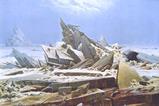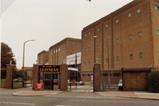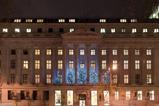Readers familiar with the nursery rhyme Pop Goes the Weasel may be pleased to hear that while many of its allusions may now be obscure or lost to us, it is still possible to go Up and down the City Road and in and out the Eagle.
City Road was constructed in 1761 and remains a major thoroughfare between the Angel Islington and Finsbury Square. The Eagle Tavern was established towards its northern end in the early 19th century and became ‘The Royal Grecian Theatre’ for a while before reverting to its original name when it was rebuilt in 1901. Today, Greek drama is no longer on offer, though its website does highlight alternative attractions such as a courtyard garden and a weekly quiz.
In 1820, near the Eagle, City Road also became the site of a canal basin serving the Regent’s Canal. Here, goods could be offloaded from canal boats and transported the short distance to the City by waggon. With ready access to industrial towns throughout the country, the London Docks and the City, other businesses were attracted to the vicinity, including some with a microbiological flavour. At the Anti-Dry Rot Company, for example, wood was protected against decay by immersing it in tanks of mercuric chloride solution, a process known as kyanising after its inventor, the Irishman John Howard Kyan, who had demonstrated its efficacy to the Admiralty by burying treated wood in a ‘fungus pit’ in Woolwich for 3 years without apparent deterioration. Slightly more tangential, the City Road Basin was also home to W. Pitt and Co., the first successful producer of carbonated tonic water.
Tonic water’s distinctive bitter flavour (and its fluorescence under UV light) derive from quinine, a quinoline alkaloid found in the bark of the cinchona tree, native to the eastern slopes of the Andes. Its antimalarial properties were first recorded in the 1630s by an Augustinian monk who described it as being known locally as the fever tree. Consumption of an extract of cinchona bark to treat malaria spread rapidly despite objections from some who associated the practice with Catholicism. Ardent Protestant Oliver Cromwell, for example, refused to take ‘Jesuit’s bark’ shortly before his demise from a combination of malaria and kidney stone disease. Cinchona bark appeared in the London Pharmacopoeia in 1677 and when the alkaloids responsible for its activity were isolated and identified by French chemists Pelletier and Caventou in 1817, quinine became the first chemical compound used to treat an infectious disease. Its additional value as an antimalarial prophylactic was formally established by the Scottish physician William Balfour Baikie in 1854.
The malarial parasite Plasmodium is transmitted to humans by the bite of the female Anopheles mosquito. During its complex life cycle the parasite spends time multiplying in the red blood cells of an infected person at the expense of haemoglobin, utilising the globin protein and detoxifying the residual haem by converting it to haemozoin, an insoluble crystalline brown pigment, which is stored in the parasite’s food vacuole. Quinine, like chloroquine, interferes with this process, killing the parasite as toxic levels of haem accumulate within its body.
To make the bitter-tasting remedy more palatable it was often consumed mixed with wine or a potable spirit such as gin or rum. This practice in turn led to the production of ‘tonic wines’, generally extolled as a tonic and aid to digestion. These contained cinchona bark extract, and later quinine itself, dissolved in wine, usually at levels conferring flavour but insufficient for malaria prophylaxis or treatment. One surviving example of these is the French aperitif Dubonnet, notable for having been a favourite tipple of the late Queen Mother. Whether her impressive longevity (she lived to be 101) was attributable to this is a matter of speculation.
Since carbonated water (first described by Joseph Priestley in 1772) had also acquired a reputation as a panacea, its combination with quinine seems to have been an inevitability. There was short-lived production of Quinine Soda Water in 1835 in Bristol but the first successful product appears to have been Pitt’s Aerated Tonic Water, based on a patent of 1858 issued to Erasmus Bond. It was marketed, not as an antimalarial, but for giving ‘strength to the stomach and tone to the whole nervous system’, though medical endorsements, including one by the famous physician and microscopist Arthur Hill Hassall, gave great emphasis to its refreshing qualities. Pitt’s tonic water was followed by others including, in 1870, ‘Indian Tonic Water’ from a London-based company founded by Johann Jacob Schweppe using a similar recipe but employing citric acid as a more agreeable acidulant than the sulphuric acid used by Pitt.
Schweppe’s success helped establish an association of tonic water with India, the Empire more generally, and the urban myth that it was used to counter malaria, the scourge of empire builders. In fact, quinine concentrations in tonic water are typically below 83 mg/L (the US FDA limit), necessitating consumption of prodigious quantities to achieve anything approaching a clinically useful dose of 500–1000 mg. The more prosaic truth it seems is that tonic water, mixed perhaps with the merest smear of gin, is the basis of a fortifying and refreshing drink well suited to hotter climes.
Despite significant successes of mosquito control measures, quinine and other, more recent, antimalarials, malaria remains a major world health problem to this day with 241 million cases worldwide in 2020 and 627,000 deaths, mostly in children under 5 in sub-Saharan Africa. Recently however, hopes of further progress have risen when, in October 2021, after more than 30 years’ effort to develop an effective vaccine, the WHO recommended the RTS,S vaccine for use in children.
Today Pitt’s factory has long gone from its home in Wharf Road and the City Road Canal Basin has been extensively redeveloped. At its southern end, it is now reduced to a rather bleak patch of water, occasionally traversed by the Islington Boat Club, and an unadorned concrete piazza. Mind you, it’s still only a short walk to the Eagle…












No comments yet